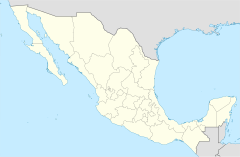El Halconazo
This article needs additional citations for verification. (October 2016) |
| El Halconazo | |
|---|---|
| Part of Dirty War | |
 Illustration of a member of the paramilitary group Los Halcones beating a demonstrator fallen on the ground, in the repression of June 10, 1971. | |
| Location | Casco de Santo Tomás, Mexico City, Mexico |
| Coordinates | 19°26′40″N 99°10′03″W / 19.44444°N 99.16750°W |
| Date | 10 June 1971 |
Attack type | Massacre |
| Deaths | 120 |
| Perpetrators | Los Halcones |
The Corpus Christi Massacre or El Halconazo (
Background
From his earliest days in office, President
On May 30 the governor of
June 10
The march started at the Casco de Santo Tomás, and proceeded through Carpio and Maestros Avenues so the protesters could take the Mexico-Tacuba Causeway, and eventually end up at
That night army elements guarded the
The number of dead in the demonstration discouraged many students, but also led others to be radicalized, some of whom later formed urban guerrilla organizations. Students in 1971 especially demanded the democratization of education, control of the university budget by students and teachers, and that it represent 12% of the
Los Halcones
The Halcones were a Mexican paramilitary group created in the late 1960s and led by Colonel Manuel Díaz Escobar, then deputy director of General Services of the Federal District Department.[2]
Legal case
In 2005, there was discussion in
In fiction
Mexican filmmaker Gabriel Retes produced, directed, and acted in a film titled El Bulto (The lump), where he portrays Lauro, a photojournalist, who was attacked by a Los Halcones member and left in a coma.[4]
The massacre is featured in the 2018 film Roma.[5]
The massacre is depicted in the first chapter of the 2021 novel Velvet Was the Night by Silvia Moreno-Garcia. One of the main characters, Elvis, is a member of Los Halcones.
See also
- Tlatelolco Massacre
- Death of Giovanni López, whose repressed protests ended up being known as the "El Halconazo Tapatío"
- Dirty War (Mexico)
- List of massacres in Mexico
- Kent State shootings
References
- ^ a b c d e f Canal 6 de Julio, Halcones: State Terrorism
- ^ Castillo García, Gustavo (9 June 2008). "El halconazo, historia de represión, cinismo y mentiras se mantiene impune". La Jornada. Retrieved 10 June 2010.
- ^ Gutierrez, Norma (2009-04-09). "Mexico: Former President Cleared of Responsibility for 1968 Student Massacre | Global Legal Monitor". www.loc.gov. Retrieved 2019-06-12.
- ^ "El bulto (1992)". IMDb.com. Retrieved 2016-10-30.
- ^ Torrealba, Isabel (2018-11-21). "The Surprising Piece of Mexican (and American) History at the Center of Roma". Slate Magazine. Retrieved 2019-02-19.

